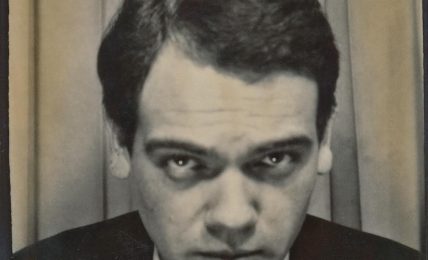Julia Rommel (b. 1980) is an American painter who uses canvases and stretchers as sculptural architecture for her work. The results are color-blocked, stretched and re-stretched canvases where the physical process of the artist’s hand is documented through layering. DigA content editor Izzy Pezzulo interviewed the artist in March (2016) during a visit and talk at the University of Richmond. We are excited to publish this interview as we re-introduce the special section Re:Analog–an exploration into analog work in a digital world–to the journal. The interview was transcribed and edited from a longer conversation. Rommel is an alum of the University of Richmond’s Department of Art and Art History (the loving home of Digital America) now lives and works in New York.
:::
DigA: How do you see the influence of digitization on the traditional art form of painting? With that in mind, how do your everyday digital experiences impact your work?
JR: That’s such a big question. I’ll start with the first things that come to mind: the first thing that everybody knows is Instagram–more than anything else. But just the fact that your work is going to appear digitally, and that it is spread digitally through social media, is something that I think all artists are aware of, painters included. It’s hard to operate without being aware of that. Even if the process of your work has nothing to do with the digital, whole art careers are made off of Instagram accounts. People ask me a lot, “Do you have to be on Instagram? Is that a big part of your career?”, and I’m always, “No, I don’t have to be on Instagram, that’s ridiculous!” But, does it have an impact? Yes. And that’s a really crazy change that’s happened over the past two or three years. I think it does affect the way people make work and show work, and where they show work. One of the interesting things that’s happened is that you can have a show, say, in Dubai or something. Five years ago no one would have seen it. Now, not too many people will see it in real life, but a lot of people will see it online. It has a lot more visibility, but also it gets into this dangerous territory. Even if you have a show in New York, where all the people who are the most important people to see it in real life are, are they just going to see it digitally? So it goes both ways. You can see a whole lot more [art], but does that mean you actually see a whole lot less in real life?
It’s very important to me that people see my work in real life. It’s always been that way, because it has so much to do with the materials, the texture, the light and shadow, and surfaces. That’s the second important thing. Myself, and a number of my peers, think about the Digital Revolution in a way that I think what I’m doing is more important than ever. There’s much that’s physical anymore; there’s not that much that’s made by hand. Paintings can be glorified way too much, which can be a little overblown sometimes. In a day-to-day process basis for me I feel really lucky that what I do hour after hour in my studio has nothing to do with a computer. Or thinking about anything in that whole communication system […] and that’s really weird when I start thinking about how rare that is, that I’m just in this room with these materials and that’s it.
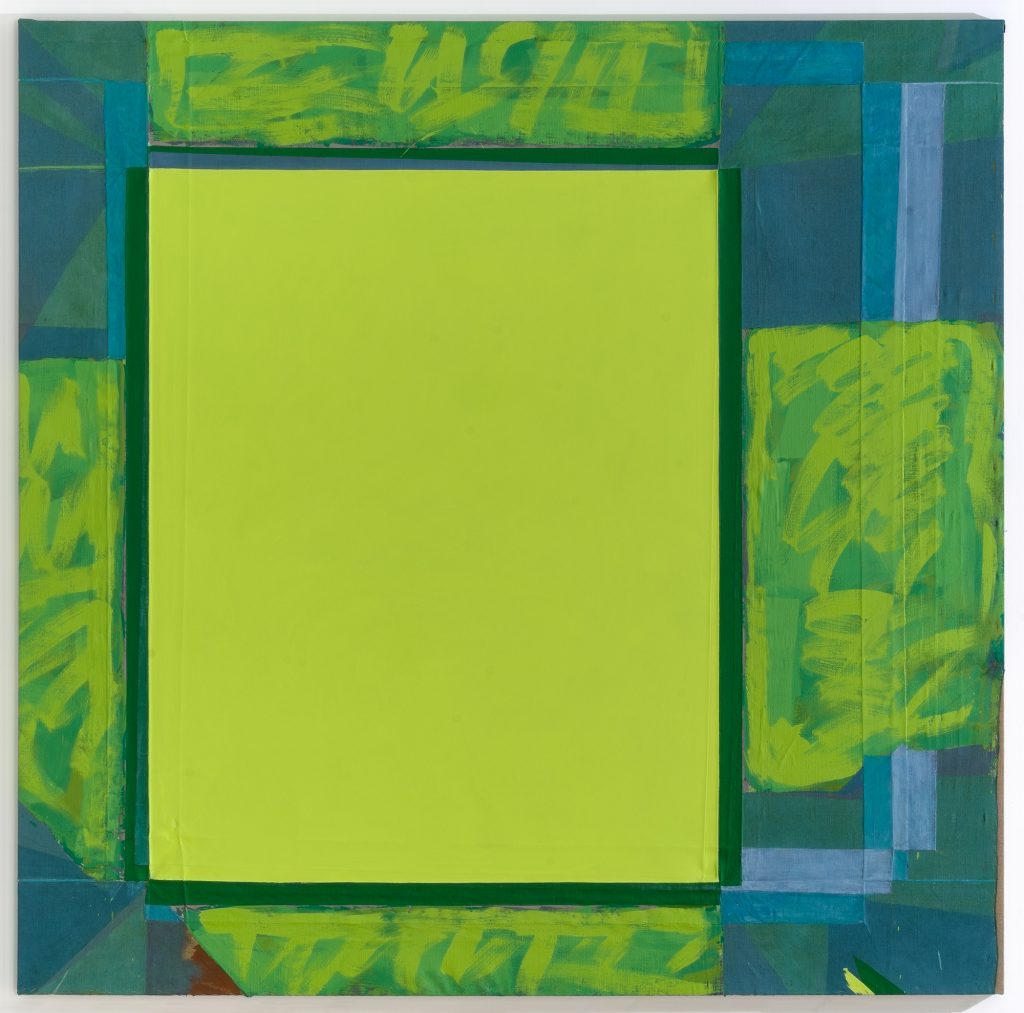
DigA: How do you feel about the way your work is viewed digitally? How do you create a primary experience from work that relies on a certain tactility?
JR: I don’t think that I personally put any energy into that. I don’t curate any experience with my paintings online. I used to have a website when I felt like I needed that, because no one else was doing it. I kind of take comfort in the randomness of it, say, on Instagram. If my work is in a show in New York, people will come and take the crappiest photos of the show. I’ll see that and think, “that’s terrible,” but then there will be a really beautiful photo that kind of hyper saturates the painting or something and makes it [appear] better than it looks in real life. I think it’s kind of crazy that it’s gotten to a point where there’re so many images of work online, and we are so aware that we might be getting an untrue experience. You know, with filters and that sort of thing, or Photoshop. You can present an entire show online, or a gallery can manipulate an entire show to make it look way better than it does in real life. [Digital] artists deal with that in so many interesting ways where they will blur those lines between what is digital and what occurs in real life. So, I take comfort in the randomness of it and I don’t want to curate it that much.
Just say that if you Google image search me, you’re going to see a lot of crappy pictures of my paintings, you’re going to see a lot of really beautiful images of my paintings, a lot of inaccurate images. That’s the internet’s depiction of painting right now. And I’m fine with my lack of control over that, because no one is coming to me and complaining–that doesn’t feel like my job. If you Google anything you’re going to get a lot of lies.
DigA: We study quite a bit about digital, internet, and “post-internet” art (if there is such a thing) in Digital America, and digital art is deeply layered. Much like your paintings, many of the foundational architecture is hidden and the layers build upon each other. What was your inspiration for building these layers through creation and destruction? Is there a digital aspect or influence?
JR: People have brought it up before that it [the paintings] reminds them of windows on your computer screen or something like that. Certainly I know what that image is, and certainly it’s in my brain somewhere. I don’t think that it has been much of an influence on my painting. I think just because the way that those layers came about was so slowly throughout the years and so much through using the material of painting–having the starting point be those inherent materials of ordinary art construction tools. Your linen, your gesso, your stretcher bars. My editing process became so much a process of covering up. My painting process, the act of painting, is in a way very mechanical, or I try not to make too many decisions or crop and layer in the actual act of putting paint on the surface. I always just want to cover an entire surface with paint. And any kind of composition to the layers or framing to the layers is through the actual, say, linen being stretched over the stretcher bar and painting the whole square that’s on the face and then unstretching it. The layers are often a way of completely changing something or covering something up that I’m unhappy with. But because it’s so sculptural throughout the process, when I unstretch it, I don’t know exactly where the edges are going to land. Or I don’t know exactly what kind of imperfect geometries will be around the edges. So, the layers are built up in that way. It started as a problem-solving process of “this color needs to be different,” or “this isn’t working.” It was so kind of slow and process-oriented that now, seeing the results, I’m bringing a lot from the outside. Like, how can I manipulate this to relate more to this architecture I’m interested in or landscape elements I’m interested in? But it wasn’t the other way around. There was no effort to make it look like anything in the beginning.
It makes you realize how not trying for something–those elements out of your control–can be way more interesting than anything you’re trying to do.
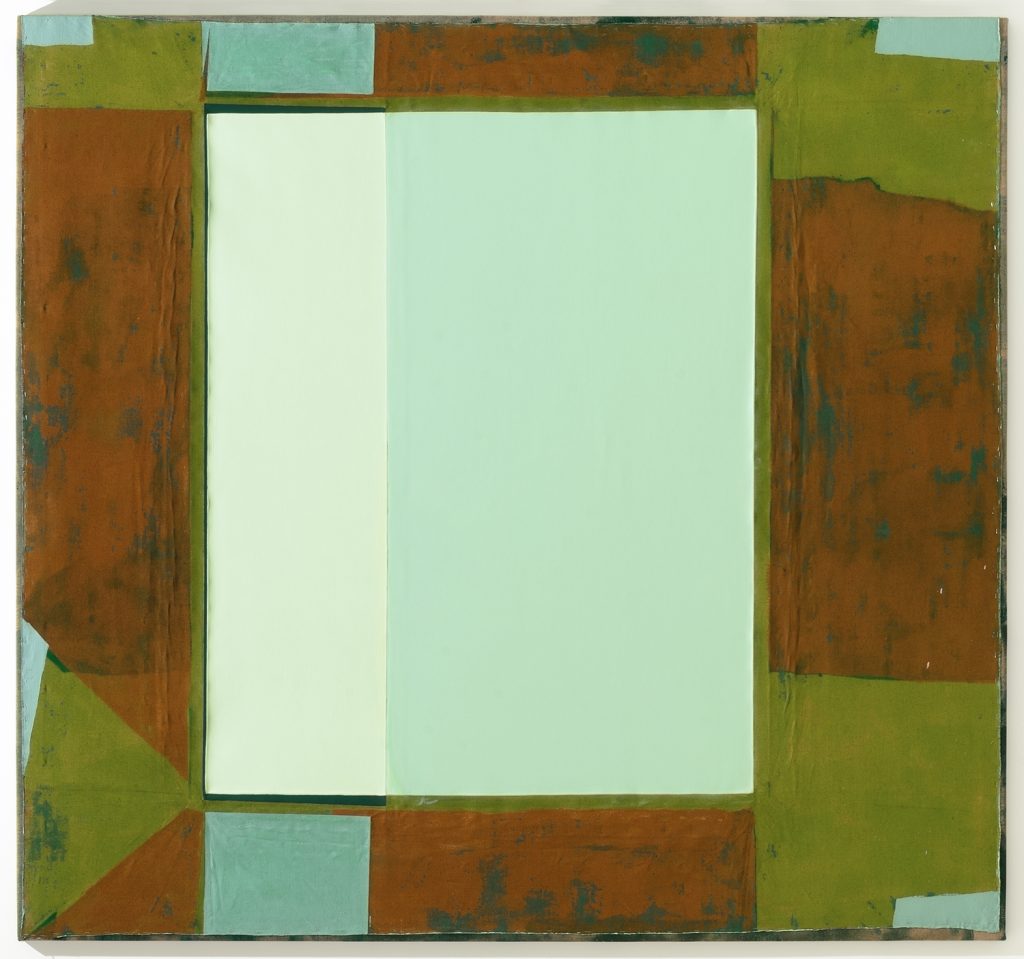
DigA: Considering the titles of your work, it’s clear that on top of working with the “analog” realm, you’ve also chosen titles that speak to experiences in that realm. Could you talk more about how you title your pieces?
JR: The physicality is what I feel gives my paintings the narrative qualities or personalities they need to be a successful painting. Titles are a good kind of litmus test for me when I am looking a painting to decide if I’m finished–if it has enough personality and humanity to it that a title comes. It reminds me of something–a memory or something–I’m thinking about. If a title comes to mind, I know it’s getting there.
Kind of like we were talking about before where so many compositional or moody elements arise in these paintings in a way that I’m not completely controlling. As if they were found objects, they summon up physical memories from when I was young; or if some kind of weird element of humor comes into play in the mark-making, and I’m thinking about a story I’ve read. It’s nice to be able to bring that narrative element into it, but because they are abstract paintings it’s never too literal.
DigA: Do you get a lot of interesting interpretations of your work?
JR: People really want to talk about process. I enjoy any kind of narrative reading into them [the paintings] even if it’s completely inaccurate. People like to read into them as far as my process being conceptual, or trying to say something really forceful about the materiality of art and chance elements in art. That’s always what makes me feel most strange, because I don’t have anything I’m trying to prove here in terms of the process and what it means. The process is serving me- but really what I am looking for is those moments when for me, it doesn’t have to tell a story to anyone else, but for me it’s creating this depth that’s a little bit narrative or gives you a feeling.
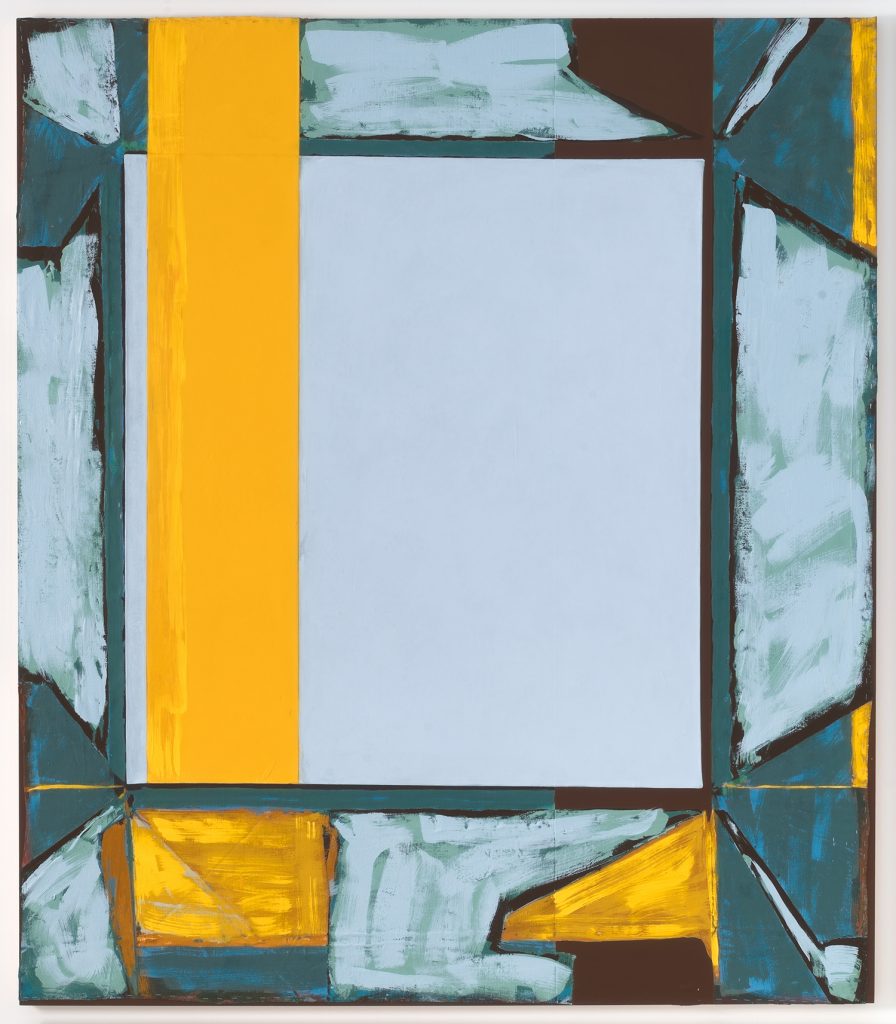
DigA: In this moment that we’re living in of art-making, what continues to motivate you to paint? What about the process is grounding to you? Perhaps more broadly, how do you operate as a contemporary painter?
JR: That’s a very good question because I struggle with it all the time. But it’s also a hard question to answer because it really changes all the time. I feel differently about it this year than I did last year. I know there are moments where, say, even when I was in school here [The University of Richmond] when I was studying painting and business, and I had no idea what I wanted to do with my life or no clue that being a painter could actually be a job. I just wanted to tuck away in the art studio and do this thing that was very familiar to me; being anxious about the entire new experience of being in college away from home. I was just like, I don’t feel comfortable anywhere else except for with these materials in this room where I’m doing this thing that I know how to do. And, it’s not that anymore. When I first started making abstract paintings (this was out of grad-school) that started this process of what I’m doing now, this kind of material, experimentation-based process, that was truly an excitement with testing things, and seeing how they turned out, and finding ways to surprise myself–or finding that I could surprise myself. That’s still it. It’s great now, because now I have this way of working. I know what to do when I get to the studio, and there’s something nice in that whereas just figuring out what I was trying to do in general was kind of awful at the time. Those first surprises of like “Whoa, this is a painting that’s weird”, were pretty exciting. So now it’s harder to surprise myself. I know what I’m doing. But there’s a lot more process, and there’s a lot more to do. So there’s something nice in that too. What else would I do? There’s so much process that needs to get done, and it feels necessary to do it.
Do you know what I want to talk about that I was just thinking of? It was with the titles and the narrative coming in–in relation to the digital world. I don’t know what I would do without the world of podcasting, or audio technology. You know, like the University of Richmond radio station, and how much that helped me be an artist when I was here [at the university]. That was music, but still I had a weird fascination with the DJs. Being alone in your studio day after day being is such an isolating experience, but having this passive relationship with these people whose voices are coming into your ears. It’s not like it was influencing my actual artwork but it was influencing my experience of being an artist, and now it’s almost exactly the same thing for me where I have this same dependency. It’s more like podcasts that are narrative, or interviews, or the news, I listen to people talking all day. That informs my paintings a lot. It’s so often showing up in the titles of my paintings. It’s not just the information. It’s the emotional connection I feel to these people who are talking to me. I’m obsessed with certain podcasts. There’s this one called the Longform podcast and it’s just these dudes talking to journalists and the dudes are so nice. It gives you a feeling of connection when you are completely by yourself, and I really don’t think I would be able to be alone in my studio if not for that.
I was pretty lonely when I was here [at the University of Richmond]. I didn’t connect with that many people here socially. So the kind of isolation I felt not just in the studio, but just in general here, and that feeling of connection I had with just some dudes I had crushes on who worked at the radio station; sometimes that gets summoned back up on me when I listening to these podcasts and making art. I guess I feel like more than television, more than anything you could watch on a screen, there’s something really intimate about being in a room with voices in your ear. It’s just right there, it’s not even across from you.
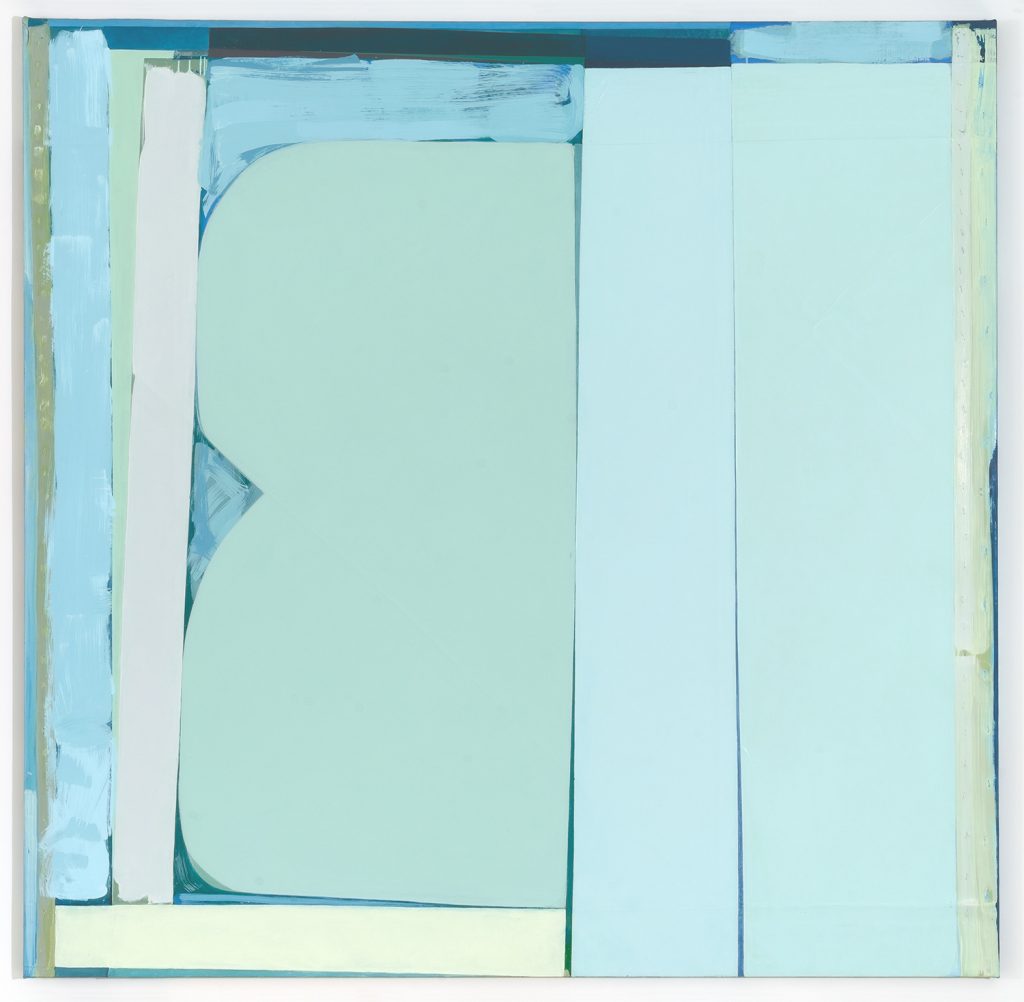
DigA: As a UR alumni, would you have been interested in working on a project like Digital America? Do you think it’s important for college students in the arts to work on publishing and curating art?
JR: Yeah, definitely. It is important, because it becomes so much of what you do when you are trying to make a career. It’s basically what you’re doing for yourself, whether you’re trying to put together a digital magazine that’s a totally collaborative thing […] Even as an artist, once I started being a little more confident about what I was making, immediately what you first have to do is be, “Okay, I’ve got to get a website together. I’ve got to publish my art, so that someone sees it somehow.” It’s necessary [to do some kind of digital publishing] to have a career in the real world. I certainly would have wanted to be involved in something like Digital America just because it’s so fun and interesting, you’re working with people, you’re asking a ton of people good questions […] what’s not good about it?

